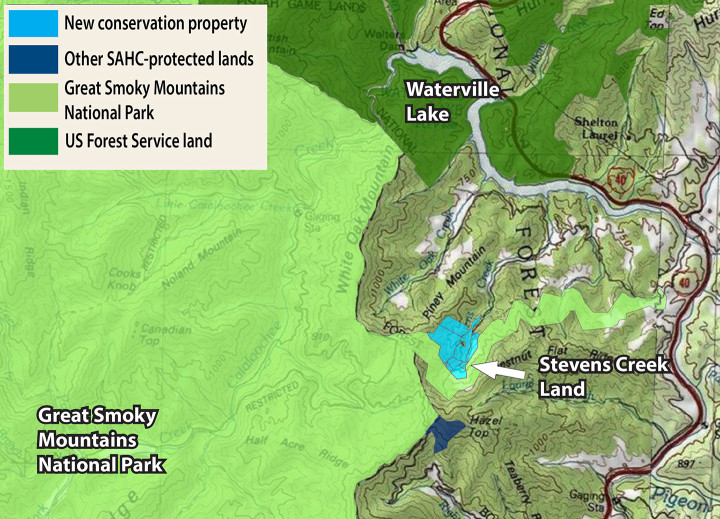The Southern Appalachian Highlands Conservancy (SAHC) recently purchased 147 acres at Stevens Creek, a quiet cove on the eastern edge of the Great Smoky Mountains National Park (GSMNP).
The acquisition permanently protects important habitat and water resources near the remote Cataloochee Valley area of the park.
“Wrapped on three side by publicly owned land, this pocket of prime forest and open pasture habitat will remain undeveloped for future generations,” says Carl Silverstein, SAHC’s executive director. “The acquisition presents a wonderful opportunity for SAHC to deepen our connection to America’s most visited national park.”

Located at the northern end of Cataloochee Ridge in Haywood County, the recently purchased Stevens Creek conservation land shares over 7,000 feet of boundary with a portion of the national park that serves as a key wildlife corridor for rare and threatened species, including keystone species such as the introduced Rocky Mountain Elk. SAHC and its partners at the National Parks Conservation Association, the Wilderness Society and the Rocky Mountain Elk Foundation considered the tract a high conservation priority because of its location and exceptional habitat.
“Protecting this land is critical for the elk, black bear and other animals moving in and out of Great Smoky Mountains National Park,” says Jeffrey Hunter, Southeast regional program manager for National Parks Conservation Association. “Wildlife aren’t aware of park boundaries and protecting lands adjacent to the Great Smokies provides protection for the animals, and creates corridors for them to move freely. This land acquisition is a critical step in preserving the biodiversity of this special region.”
The Great Smoky Mountains National Park has been ranked as America’s most visited national park for more than a decade, with over 11.3 million recreation visits reported last year. Designated an International Biosphere Reserve and World Heritage Site, the park contains exceptional biological diversity and 10,000 known species of plants and animals.
“Elk, turkey, deer and other wildlife need a place to live and something to eat,” says Kim Delozier, Rocky Mountain Elk Foundation’s Conservation Program Manager for the Eastern US. “It’s exciting to know that this land adjacent to Great Smoky Mountains National Park will be forever protected and managed as an opening, habitat that many of our Smoky Mountain critters need. Our hats are off to SAHC for making this happen.”
In 2001, elk were released into Cataloochee Valley as park of an experimental program to reintroduce elk to the park. Visitors enjoying watching elk, as well as wild turkey, deer, and other wildlife, across the open fields of the valley during early morning and evening hours.
“Conservation of the Stevens Creek tract benefits both wildlife and recreational users of these rugged mountain areas,” adds Silverstein. “We are very grateful to Brad and Shelli Stanback for making a generous gift that made this land acquisition possible.”
Almost three miles of streams flow across the property, including headwater tributaries of Stevens Creek. Stevens Creek drains directly into Waterville Lake, a popular boating, angling, and recreation site in the Pigeon River watershed.

